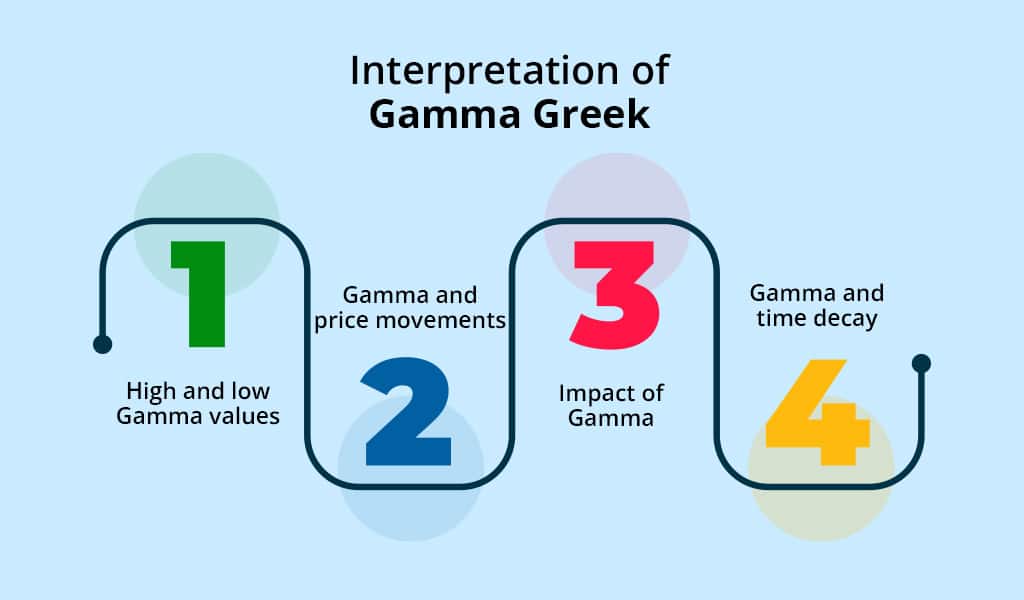Understanding Gamma in Options Trading
Understanding Gamma in Options Trading
A Comprehensive Guide for Risk Management

Introduction
In the dynamic and complex world of options trading, understanding and effectively managing risk is paramount to success. Among the various tools and metrics available to traders, one often overlooked but crucial element is Gamma. This comprehensive guide will delve into the intricacies of Gamma, its significance in risk management, and how traders can leverage this powerful metric to enhance their trading strategies.
What is Gamma?
Gamma is one of the “Greeks” in options trading, a set of risk measures denoted by Greek letters. Specifically, Gamma measures the rate of change in an option’s Delta for each one-point move in the underlying asset’s price. To fully grasp the concept of Gamma, it’s essential to understand its relationship with Delta.
The Relationship Between Gamma and Delta
Delta, another crucial Greek, represents the sensitivity of an option’s price to changes in the price of the underlying asset. In simpler terms, Delta indicates how much an option’s price is expected to change for a $1 move in the underlying asset.
Gamma, therefore, can be thought of as the acceleration of an option’s price change. It measures how quickly Delta changes as the underlying asset’s price moves. This relationship makes Gamma a second-order derivative of the option’s price with respect to the underlying asset’s price.
The Importance of Gamma in Options Trading
Understanding Gamma can provide traders with a significant edge in the market. Here are several key reasons why Gamma is crucial in options trading:
- Price Sensitivity: Gamma helps traders anticipate how quickly an option’s price might change as the underlying asset moves. This is particularly important for options near their expiration date, where Gamma tends to increase dramatically.
- Risk Management: By monitoring Gamma, traders can better assess and manage their portfolio’s risk exposure. High Gamma positions can lead to rapid changes in portfolio value, both positively and negatively.
- Delta Hedging: Gamma is essential for traders employing Delta hedging strategies. It helps in maintaining a Delta-neutral position by indicating how often the hedge needs to be adjusted.
- Volatility Insights: Gamma can provide insights into market volatility. Higher Gamma values often indicate higher implied volatility, which can be valuable information for traders.
- Profit Potential: Understanding Gamma can help traders identify opportunities for significant profits, especially in rapidly moving markets.
How Gamma Behaves
To effectively use Gamma in trading strategies, it’s crucial to understand how it behaves under different conditions:
Time to Expiration
As an option approaches its expiration date, Gamma typically increases for at-the-money options. This means that Delta becomes more sensitive to changes in the underlying asset’s price, leading to more dramatic price swings in the option.
For example, consider a stock trading at $100 with a call option strike price of $100. As expiration nears, even a small move in the stock price (say, to $101) could cause a significant change in the option’s Delta, potentially moving it from 0.5 to 0.7 or higher.
Moneyness
Gamma is usually highest for at-the-money options and decreases as options move further in-the-money or out-of-the-money. This is because at-the-money options have the highest uncertainty regarding whether they will expire in-the-money or out-of-the-money.
For instance, a call option with a strike price of $100 when the underlying stock is also at $100 will have a higher Gamma than a call option with a strike price of $120 or $80 for the same stock.
Volatility
Increased volatility in the underlying asset generally leads to lower Gamma values for at-the-money options. This is because higher volatility increases the uncertainty of the option’s final value at expiration.
In a high-volatility environment, the price of the underlying asset is expected to fluctuate more, which reduces the impact of small price changes on the probability of the option expiring in-the-money or out-of-the-money.
Calculating Gamma
While the exact calculation of Gamma involves complex mathematical formulas, it’s useful to understand the basic principle. Gamma is the second derivative of the option price with respect to the underlying asset price. In other words, it’s the rate of change of Delta.
The formula for Gamma is:
Γ = ∂Δ / ∂S
Where: Γ (Gamma) is the rate of change of Delta with respect to the underlying price Δ (Delta) is the rate of change of the option price with respect to the underlying price S is the price of the underlying asset
In practice, traders typically rely on options pricing models and software to calculate Gamma, as manual calculations can be complex and time-consuming.
Strategies for Leveraging Gamma
Traders can employ several strategies to capitalize on Gamma:
- Gamma Scalping: This strategy involves taking advantage of Gamma by making frequent adjustments to a Delta-hedged position. As the underlying asset’s price moves, traders buy or sell shares to maintain a Delta-neutral position, potentially profiting from the Gamma effect. For example, a trader might buy 100 shares of a stock and simultaneously sell a call option. As the stock price changes, the trader adjusts the stock position to remain Delta-neutral, potentially profiting from these small adjustments.
- Long Gamma Strategies: These involve buying options to benefit from large moves in the underlying asset. Long Gamma positions can lead to significant profits if the market moves substantially in either direction. A common long Gamma strategy is a straddle, where a trader buys both a call and a put option with the same strike price and expiration date. This position profits from large price movements in either direction.
- Short Gamma Strategies: These involve selling options to benefit from time decay and small moves in the underlying asset. However, short Gamma positions can lead to substantial losses if the market moves dramatically. An example of a short Gamma strategy is selling a strangle, where a trader sells both an out-of-the-money call and an out-of-the-money put. This strategy profits if the underlying asset remains relatively stable.
- Gamma Hedging: This involves adjusting positions to manage overall portfolio Gamma exposure, reducing the risk of large swings in portfolio value. For instance, a trader with a large short Gamma position might buy long-dated options to reduce their overall Gamma exposure and protect against large market moves.
Risks Associated with Gamma
While Gamma can provide significant opportunities, it also comes with risks that traders must be aware of:
- Magnified Losses: Just as Gamma can magnify profits, it can also lead to substantial losses, especially for short Gamma positions in volatile markets. A sudden, large move in the underlying asset can result in significant losses for short option positions.
- Increased Transaction Costs: Strategies that involve frequent position adjustments based on Gamma can lead to higher transaction costs, potentially eating into profits. This is particularly true for Gamma scalping strategies.
- Model Risk: Gamma calculations are based on theoretical models, which may not always accurately reflect real-world market conditions. Traders should be aware that these models have limitations and may not perfectly predict option behavior.
- Liquidity Risk: In illiquid markets, it may be challenging to execute the frequent trades required for some Gamma-based strategies. This can lead to slippage and suboptimal trade execution.
- Pin Risk: For options near expiration with high Gamma, there’s a risk of the underlying asset price finishing very close to the strike price. This can lead to uncertainty about exercise decisions and potential losses.
Best Practices for Managing Gamma Risk
To effectively manage Gamma risk, consider the following best practices:
- Regular Monitoring: Continuously monitor your positions’ Gamma exposure, especially for options nearing expiration. Use options trading platforms or risk management software to keep track of your Gamma levels.
- Diversification: Spread your Gamma risk across different strike prices, expiration dates, and underlying assets. This can help mitigate the impact of large moves in any single position.
- Set Limits: Establish and adhere to pre-defined Gamma exposure limits for your portfolio. This might involve setting maximum Gamma levels for individual positions and for your overall portfolio.
- Use of Other Greeks: Consider Gamma in conjunction with other Greeks like Vega and Theta for a more comprehensive risk management approach. For example, a position with high Gamma might be balanced with positions that have favorable Theta (time decay) characteristics.
- Stress Testing: Regularly conduct stress tests on your portfolio to understand how different market scenarios might affect your Gamma exposure. This can involve simulating large market moves and assessing the potential impact on your positions.
- Education and Practice: Continuously educate yourself about Gamma and practice using it in simulated trading environments before applying strategies in live markets. Many brokers offer paper trading accounts that allow you to test strategies without risking real money.
- Adjust Positions Proactively: Don’t wait for large market moves to adjust your positions. Regularly review and adjust your portfolio to maintain your desired Gamma exposure.
- Consider Time Decay: Remember that Gamma changes as time passes and the option nears expiration. Be prepared to adjust your strategies as the time to expiration decreases.
Tools for Gamma Analysis
Several tools can aid in Gamma analysis and management:
- Options Calculators: These tools can quickly compute Gamma values for different options. Many online platforms offer free options calculators that allow you to input various parameters and see how they affect Gamma.
- Risk Management Software: Advanced software can provide real-time Gamma calculations and portfolio-level risk analysis. These tools often offer features like scenario analysis and can help you visualize your Gamma exposure across different market conditions.
- Gamma Ladders: These visual tools display Gamma exposure across different strike prices, helping traders identify areas of high risk or opportunity. Gamma ladders can be particularly useful for understanding how your Gamma exposure changes at different price levels of the underlying asset.
- Monte Carlo Simulations: These can help traders understand potential outcomes of different Gamma exposures under various market scenarios. By running thousands of simulations, you can get a better sense of the range of possible outcomes for your trading strategies.
- Options Chain Analysis: Many trading platforms offer detailed options chain analysis tools that include Gamma values. These can be useful for quickly comparing Gamma across different strike prices and expiration dates.
- Charting Software: Some advanced charting software includes the ability to plot Gamma values over time or against other variables. This can help in visualizing trends and patterns in Gamma behavior.
Real-World Applications of Gamma
Understanding how Gamma applies in real-world trading scenarios can help solidify your grasp of this important concept:
- Earnings Announcements: Companies often experience increased volatility around earnings announcements. Traders might use long Gamma strategies to profit from potential large moves, while being aware that implied volatility (and thus option prices) often decrease after the announcement.
- Market Crashes: During sudden market downturns, Gamma can play a significant role. As prices fall rapidly, short Gamma positions (like those held by option sellers) can lead to forced selling of underlying assets to maintain Delta hedges, potentially exacerbating the market decline.
- Dividend Capture: Traders employing dividend capture strategies need to be aware of how Gamma affects their positions, especially as ex-dividend dates approach and options near expiration.
- Volatility Trading: Gamma is closely related to volatility. Traders focusing on volatility strategies, such as variance swaps or volatility index (VIX) options, need to understand how Gamma affects their positions.
- Portfolio Insurance: Institutional investors sometimes use options for portfolio insurance. Understanding Gamma is crucial for effectively implementing and managing these protective strategies.
Conclusion
Gamma is a powerful and complex metric in options trading. While it can lead to significant profits when used effectively, it also carries substantial risks. A deep understanding of Gamma, its behavior, and its implications is crucial for any serious options trader.
By incorporating Gamma analysis into your trading strategy, you can gain valuable insights into potential price movements, manage risk more effectively, and identify profitable opportunities. However, always remember that Gamma is just one piece of the puzzle. A comprehensive approach to options trading should consider all the Greeks, market conditions, and your overall investment goals.
As with any advanced trading concept, continuous learning and practice are key to mastering Gamma. Stay informed about market developments, regularly review and adjust your strategies, and always be prepared for the unexpected. With diligence and expertise, Gamma can become a valuable ally in your quest for options trading success.
Remember, while Gamma provides powerful insights, it’s not a crystal ball. Market behavior can be unpredictable, and no single metric can guarantee trading success. Always use Gamma in conjunction with other analysis tools, risk management techniques, and a solid understanding of market fundamentals.
By mastering Gamma and other options Greeks, you’ll be better equipped to navigate the complex world of options trading, manage your risk effectively, and potentially uncover profitable opportunities that others might miss. Whether you’re a novice trader just starting to explore options or an experienced professional looking to refine your strategies, a solid grasp of Gamma is an invaluable asset in your trading toolkit.
Check out our articles on:
- Introduction to Options Trading
- Mastering Butterfly Spreads
- The Power of Diagonal Spreads
- The Power of Iron Condors
- The Power of Vertical Credit Spreads
Elevate Your Options Trading Skills
Ready to master trading options? Join our community for in-depth education on options trading, live trading sessions, and expert analysis of options trading strategies. Sign up today to start profiting from market swings using advanced options trading strategies!
Below are the links:
To your success,

Billy Ribeiro is a renowned name in the world of financial trading, particularly for his exceptional skills in options day trading and swing trading. His unique ability to interpret price action has catapulted him to global fame, earning him the recognition of being one of the finest price action readers worldwide. His deep comprehension of the nuances of the market, coupled with his unparalleled trading acumen, are widely regarded as second to none.
Connect with us:






